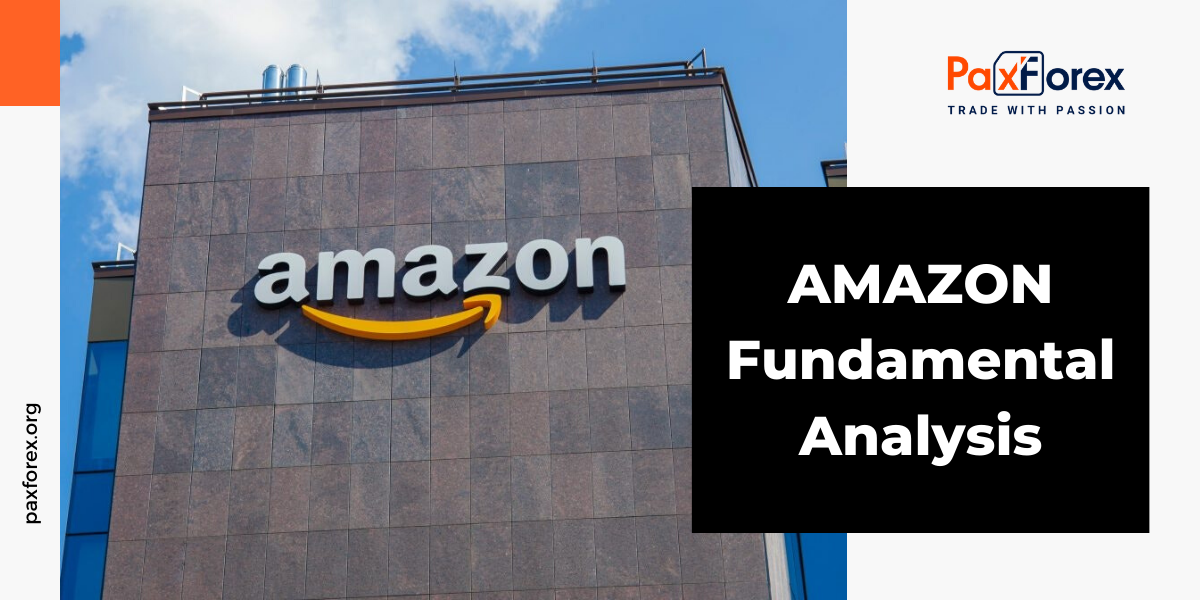
Source: PaxForex Premium Analytics Portal, Fundamental Insight
It's no secret that Amazon has been among the top-performing stocks in the past decade, making it one of the market's most rewarding stocks despite its relatively young age as a company.
However, the adage "past performance is no guarantee of future results" rings true. Amazon appears to be facing challenges in sustaining its historical growth momentum, evident in its recent move to a new 52-week high, which weakens the bullish case for entering the stock at this point.
Nevertheless, potential investors should not dismiss the idea of acquiring Amazon stock solely based on its less compelling future outlook. While the e-commerce giant may not replicate the remarkable near-200,000% gain since its 1997 IPO, it still holds significant upside for shareholders.
Acknowledging that Amazon's highest-growth days in e-commerce may be behind it, the competitive landscape has evolved, and much of the addressable e-commerce market has already been tapped. Despite competitive pricing, an extensive network of warehouses, and substantial logistics expenses, the profit margins for Amazon's e-commerce operation were not exceptionally high.
However, the future trajectory of Amazon is not solely dependent on e-commerce. Instead, it serves as a means to an end.
In recent years, Amazon has capitalized on its advertising opportunity by accepting payments from third-party sellers to prominently feature their products. This strategy, coupled with sponsored listings, has contributed to over $12 billion in ad revenue during the three-month period ending in September. The trailing-12-month ad revenue now stands at $43.8 billion, marking a 22% year-over-year increase. This shift toward advertising presents a new avenue for growth, signaling that Amazon's future potential extends beyond its historic e-commerce success.
While the $12 billion in ad revenue Amazon collected during the three-month stretch ending in September may seem like a small fraction compared to its projected $528 billion in total business for the year, this evolving business model holds transformative potential for the company. The introduction of advertising revenue introduces a high-margin income stream, prompting speculation that Amazon.com could potentially generate more profit as an advertising platform than as an operator of an extensive online marketplace. In essence, the company could absorb losses on direct product sales and still offset them significantly with advertising revenue.
This shift in focus has not gone unnoticed, with market research firm Insider Intelligence projecting Amazon's advertising business to grow to just under $45 billion for the fiscal year ending this month, and further projecting a substantial increase to $67.6 billion by 2025. This trajectory suggests that Amazon's foray into advertising is just beginning. Insider Intelligence goes a step further, forecasting the entire retail media ad market in the United States - charging brands to be featured on an online shopping platform - to surge from $46.4 billion in the current year to over $109 billion in 2027.
Given Amazon's dominant position, accounting for approximately 40% of the nation's e-commerce revenue and attracting significantly more traffic than its competitor shopping sites, it's logical to expect the company to capture a substantial share of this anticipated growth. Amazon's strategic positioning positions it favorably to leverage its widespread reach and solidify its presence in the expanding landscape of online retail advertising.
Despite the saturation of the low-margin e-commerce market, Amazon stock remains an attractive buy, and there are two key reasons for this: advertising revenue and cloud computing.
Amazon's move into advertising introduces a high-margin income stream that could potentially outweigh profits from its extensive online marketplace. Market research suggests that Amazon's advertising business is poised for substantial growth, reaching nearly $45 billion by the end of the fiscal year and projected to hit $67.6 billion by 2025. This aligns with the broader trend in the US retail media ad market, forecasted to surge from $46.4 billion in the current year to over $109 billion in 2027.
Additionally, Amazon's dominance in cloud computing through Amazon Web Services (AWS) is a significant factor. While AWS contributes around 16% to Amazon's top line, it accounts for approximately three-fourths of the company's overall profits. As the global cloud services market continues to expand at a rapid pace - anticipated to reach $2 trillion by the early 2030s - AWS's revenue could nearly quadruple over the next decade, with yearly operating profits potentially reaching around $100 billion.
Despite Amazon stock's recent surge and seemingly high valuation, it has historically defied market standards due to its above-average growth potential. The stock's current trailing price/earnings ratio of nearly 80 and forward-looking P/E of almost 40 may seem frothy, but Amazon's track record suggests that investors are willing to pay for its growth and reliability. Analysts, despite the recent bullish run, remain optimistic, with 48 out of 57 analysts rating it a strong buy and a consensus price target of $176.44, indicating nearly 20% upside from the current price.
As long as the price is above 145.00, follow the recommendations below:
- Time frame: D1
- Recommendation: long position
- Entry point: 153.17
- Take Profit 1: 160.00
- Take Profit 2: 170.00
Alternative scenario:
If the level of 145.00 is broken-down , follow the recommendations below:
- Time frame: D1
- Recommendation: short position
- Entry point: 145.00
- Take Profit 1: 139.00
- Take Profit 2: 132.00













